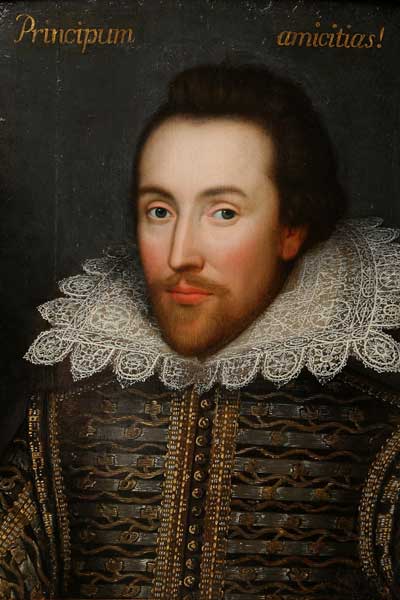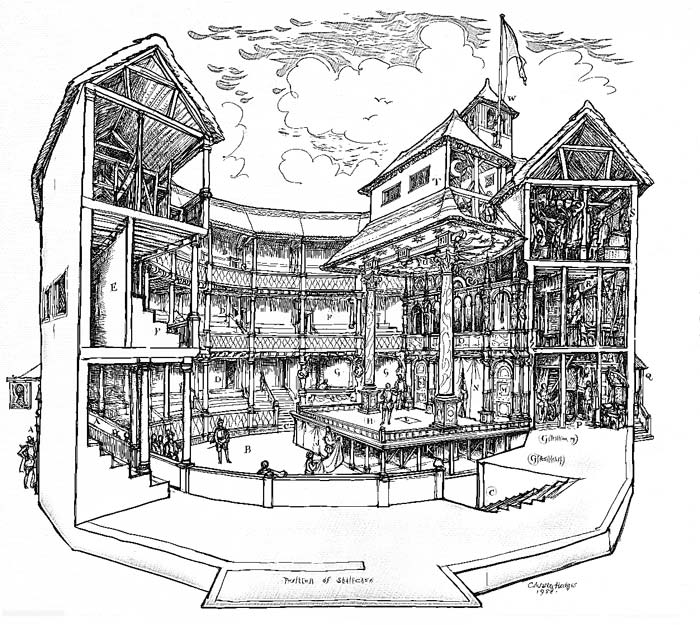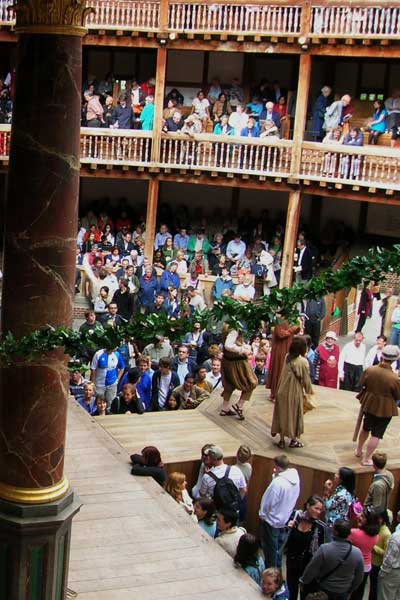
William Shakespeare, “the Bard of Avon,” was born in 1564 in Stratford-upon-Avon in Warwickshire, England, during the reign of Queen Elizabeth I. He wrote nearly 40 known plays, covering comedies, tragedies, historical plays, tragicomedies, and romances, and more than 150 sonnets. His plays were not all acted out in one place or even one type of venue; playwrights of his time had to adapt to indoor and outdoor environments and various types of audiences.
In some cases, they would have to cater to more than one type of audience at the same time. Rather than rely on lavish stages and props, they would rely on colorful descriptions to set the scene.
Elizabethan Playhouses
Shakespeare’s plays were performed in or around London, England, starting in the 1590s. Shakespeare and his company, the Lord Chamberlain’s Men, played primarily at The Theatre, built by actor James Burbage in 1576, then at the Curtain Theatre, 200 yards away, after The Theatre was closed down in 1597. Shakespeare and his company moved to the Globe Theatre as of 1599; this venue was built in part with materials taken from The Theatre. A fire broke out at the Globe, destroying the building, in 1613, but it was rebuilt a year later.

In addition, the group dubbed the King’s Men after James I took the throne in 1603, used the second venue starting in 1608. At Blackfriars, a former Dominican monastery, the King’s Men had the use of a private indoor theater, allowing them to perform in comfort during the winter months. The Globe had a capacity of 3,000 people and was the site of most of Shakespeare’s performances, while Blackfriars was thought to have a capacity of almost 1,000. They also performed at smaller, expensive private theaters and indoor playhouses.
Plays at the Globe typically occurred during the day due to the fact that there was no way to light the theater safely at night. London had suffered at least two catastrophic fires, and straw used in the pit area was a major fire risk, precluding the use of torches. Plays happening at night were also unsafe due to the threat of assaults, especially since there was no police presence in the area. Night performances were, however, possible at the Blackfriars theater.

The Audience
At the Globe, three types of audiences typically appeared to watch Shakespearean plays. Two were the educated middle- and upper-class citizens who sat in the more expensive gallery seating area in the middle and upper part of the theater. The middle seating cost two pennies, and the upper area cost three pennies. This crowd came to hear the story and the ideas that were being presented, as well as to appreciate the characters and subtle messages. The other audience was the common people, who paid a single penny, stood in the noisy and unsavory pit area, and were more interested in violent action and relatively crude jokes. The audience in the pit tended to jeer at the stage and throw food when they watched for too long without seeing the plebeian elements that they came to see. Shakespeare preferred Blackfriars for its lack of pit space and because it attracted an audience with more money and education.
Acting and Stage Design
All actors in plays at the time, including Shakespearean shows, were male, even when a story called for female characters. Their performances required significant skill beyond mere acting prowess, including fencing, singing, and dancing. During this time period, theater stages did not use elaborate scenery, relying on only the most essential furnishings, like a bed, throne, grave, armor, weapons, and chairs. The stages were rigged so that actors were able to come down or speak to the audience from the ceiling, or the “heavens,” or enter and leave through a trap door to represent the underworld. Their costumes were not intended for historical accuracy but generally consisted of extravagant modern clothing, some of which had previously been worn by nobility.
Shakespeare’s Legacy
Shakespeare died in 1616, after three years of retirement. Seven years later, Henry Condell and John Heminges compiled his plays into a work known as the First Folio, in which playwright Benjamin Johnson referred to Shakespeare as one to be remembered for all time. In 1642, however, the English Civil War erupted between the Parliamentarians, or Puritans, and the Royalists, during which plays were outlawed. Two years later, the Puritans destroyed the Globe Theatre, and in 1648, they ordered all playhouses to be destroyed. The Puritan victory, led by Oliver Cromwell, was blunted by his death in 1658 and the Restoration in 1660.
True to Benjamin Johnson’s prediction, Shakespeare’s works have achieved a fame that has lasted for centuries. Scholars have translated his plays into almost every known language for performances around the world. Many expressions that Shakespeare first coined, such as “brave new world,” “sterner stuff,” “bated breath,” and “foregone conclusion,” have become common terms in the English language. In addition, he changed the way that we use some words to this day, such as using “accused” and “backing” as nouns, “champion” and “cater” as verbs, and the adjectives “juiced” and “deafening.”


